Wi-Fi 6 Column | Easy Understanding of the Next-generation Wi-Fi
What is Wi-Fi 6?
Wi-Fi 6, also known as 802.11ax, is the next generation of the Wi-Fi standard, the latest step in a journey of nonstop innovation.

What can we expect from Wi-Fi 6?
Wi-Fi 6 is built on success of Wi-Fi 5 (802.11ac), and boosts a great leap in spatial reuse efficiency through enhanced coding and scheduling. With Wi-Fi 6, each AP can simultaneously communicate with more devices and allow higher-density deployment, reduced delays, larger coverage, and higher speeds. Moreover, performance improvement brought by Wi-Fi 6 prolongs battery life and is particularly friendly to battery-based Internet of Things (IoT) devices.
With improved efficiency, flexibility, and scalability, Wi-Fi 6 enables a faster speed and a larger capacity for next-generation advanced applications, such as seamless mobile roaming, 4K or 8K videos, high-definition collaboration applications, all-wireless office, IoT, and even applications in high-density environments.
Wi-Fi 6 will soon be applied to scenarios of conferences with tens of thousands of users, high-density office, wireless production, smart teaching, smart media, digital cities, and enterprises with revolutionary user experience enhancement.
How does Wi-Fi 6 enhance user experience?
Wi-Fi 6 enhances user experience via the following technical features:
Higher-order modulation scheme (1024-QAM), more subcarriers, and lower inter-frame space overheads: With these technologies, Wi-Fi 6 increases a theoretical maximum connection rate (in a case of a 160 Mbps bandwidth and 8 spatial flows) from 6.9 Gbps to 9.6 Gbps.
Multi-user transmission: namely, the uplink/downlink multi-user multiple-input multiple-output (MU-MIMO) and uplink/downlink orthogonal frequency division multiple access (OFDMA), which can increase the concurrency capability and the average terminal rate in high-density deployment scenarios.
Basic service set (BSS) coloring: Improves the interference immunity of wireless systems.
Target wakeup time (TWT): Enables better power saving and management.
The following uses road traffic as an example to describe in detail how Wi-Fi 6 enhances user experience. In this example, a road is equivalent to a frequency band for Wi-Fi, with limited and fixed frequency band resources, and vehicles on the road are like packets varying in size and transmission rate.
1024-QAM
Quadrature amplitude modulation (QAM) is a two-dimensional lattice modulation scheme which converts a data signal "01" into a radio wave.
Wi-Fi 6 supports 1024-QAM (2^10 bits/symbol), and has its modulation capability increased by 25% compared to that of 256-QAM (2^8 bits/symbol) supported by Wi-Fi 5. This improvement is like road optimization. That is, on one road, we can narrow down the lane width to have more lanes, without causing traffic chaos.
256-QAM |
vs. |
1024-QAM |
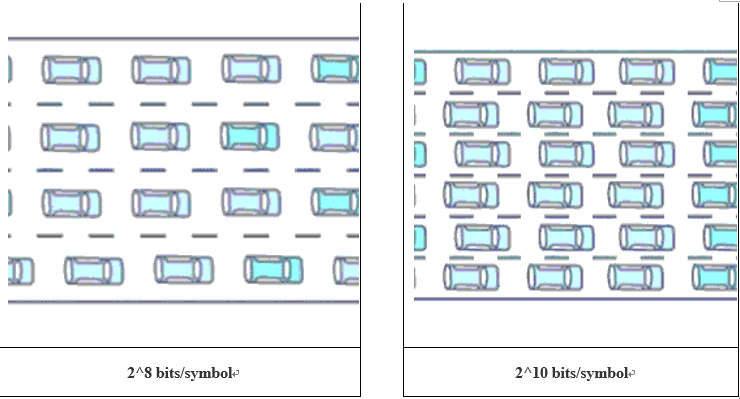
MU-MIMO and OFDMA
OFDMA
OFDMA divides a radio channel into multiple sub-channels (subcharriers) to form frequency resource blocks. User data is carried on the resource blocks, instead of occupying the entire channel, so that multiple users can transmit data concurrently in the same time period.
Metaphorically speaking, in the orthogonal frequency division multiplexing (OFDM) scheme of Wi-Fi 5, goods are delivered by order, and one vehicle is dispatched for one order, even if the order just specifies one single piece of small item. In this case, the vehicle's compartment is often empty, leading to low efficiency and wasted resources. Comparatively, in the OFDMA scheme of Wi-Fi 6, a truck is not dispatched until it is fully loaded with goods of merged orders, so that much higher transmission efficiency is achieved.
OFDM |
vs. |
OFDMA |
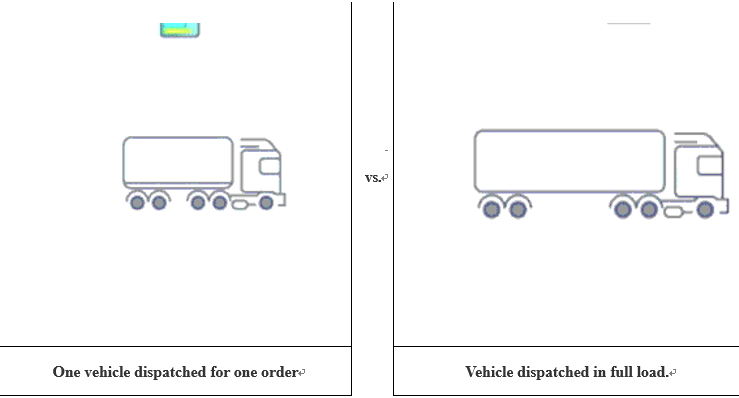
MU-MIMO
MU-MIMO allows one router to communicate with multiple devices simultaneously.
Specifically, MU-MIMO of Wi-Fi 5 allows one router to communicate with four devices at a time and supports only downlink MU-MIMO. With better performance, MU-MIMO of Wi-Fi 6 allows one router to communicate with up to eight devices in the meantime and supports both uplink and downlink MU-MIMO.
In the preceding metaphorical example, such a difference means that four lanes on the road are increased to eight lanes, and vehicles (devices) no longer queue at and move through the same exit, but can simultaneously and efficiently move in or out on different lanes.

OFDMA vs. MU-MIMO
These two technologies are different though they have something in common: both enable multi-user uplink and downlink transmission and increase wireless access density. OFDMA and MU-MIMO are parallel transmission solutions and are complementary to each other. They comply with different technical theories and are applicable to different scenarios, and should be used based on service application types.
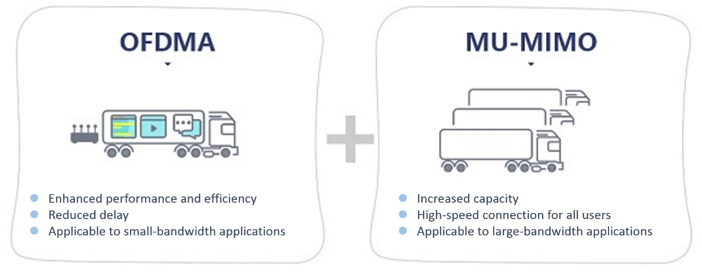
BSS coloring
A 6-bit identifier is added to the packet header to differentiate between BSSs of APs on the same channel. In this way, when an AP receives a packet destined for another AP, the AP can discard the packet to avoid a conflict by only decapsulating a physical preamble, instead of decapsulating the entire packet as in existing solutions. BSS coloring enables more orderly and certain use of channel resources, and can boost a sharp improvement to overall system performance in high-density environments.
In the preceding metaphorical example, such practice is equivalent to dividing one lane into mutually independent underpass and overpass lanes in space and dispatching vehicles to the lanes according to transmission destinations, for effective spatial reuse.
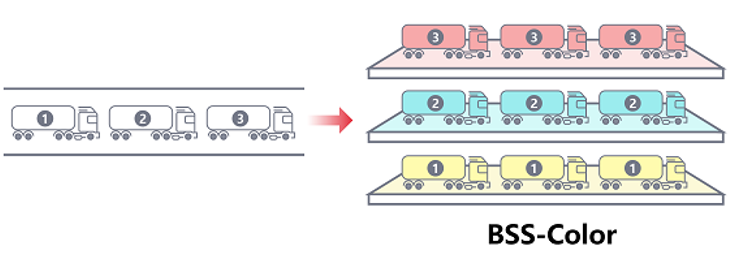
TWT
TWT enables APs to schedule communication with devices, negotiate when and how frequently the devices will wake up to send or receive data, and group terminals to different TWT periods. TWT reduces time required for keeping the antenna powered on for signal transmission and searching, thereby decreasing battery power consumption and prolonging the battery life, and reducing the number of devices contending on radio resources.
Wi-Fi 6 is applicable to various types of intelligent devices such as smart water meters, smoke sensors, and door control devices in future intelligent building scenarios, as well as machine tools, automatic guided vehicles (AGVs), and warehousing code scanning devices in future intelligent factory scenarios. Owing to TWT, each device can separately build a "wakeup protocol". A terminal device enters the operating state only after receiving its own wakeup instructions and stays in the sleep state in the rest of time. This makes IoT devices requiring large-bandwidth communication possible, for example, intelligent office devices. TWT can reduce power consumption by up to 7 times.
However, not all devices can be benefited from TWT. For example, a laptop needs to continuously access the Internet, so it is unlikely to be much benefited from this function (or perhaps TWT is more helpful to the laptop in the sleep state). This technology is more beneficial to small devices that have low consumption and do not need to update their own states on a frequent basis.
TWT shows the determination of Wi-Fi 6 to embrace IoTs.
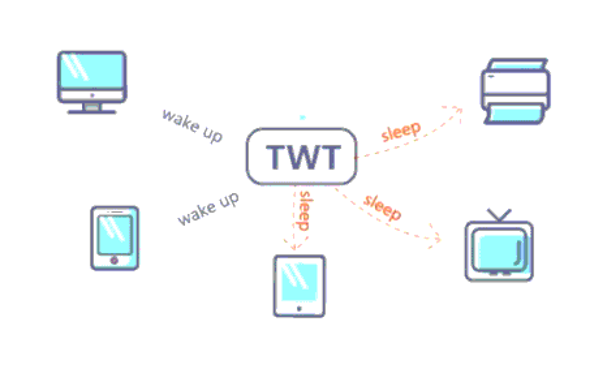
Power consumption reduced by 7 times
What are the challenges brought by Wi-Fi 6 to Wi-Fi vendors?
In conclusion, Wi-Fi 6 provides many technologies to effectively increase service efficiency of the entire Wi-Fi network. Each technology is given much free rein. For instance, the OFDMA technology provides solutions to plan most suitable subcarrier sizes and to control power of multiple users when the users simultaneously perform transmission, so as to ensure that signals of remote users are not wiped out by those of users nearby.
Aimed for ultimate user experience, Wi-Fi 6 inevitably needs to introduce AI technologies to adjust policies in real time based on changes of the environments and application types of the connected terminals, which will be the arena for major manufacturers to demonstrate their strength.
Latest news will come up for details about Ruijie Networks' Wi-Fi 6+AI.






